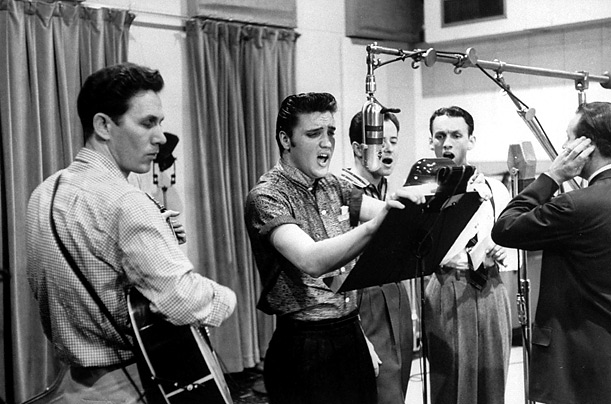Songwriting, for most of us, is a tremendously intimate experience. The magical inklings of lyrics and melodies spring to life in our minds, getting polished and reworked until they’re ready to be shared with the world.
Videos by American Songwriter
Unfortunately, the delivery is often a painful one. The way we imagine our musical creations rarely seems to translate quite right to our rough recordings. Something often gets lost, or altogether altered. This is all the more true when we ask other people– session players and certainly singers– to give voice to our work.
Are these ‘mistranslations’ inevitable? What is the best way to get our songs out there in the world as we feel them in our hearts and hear them in our heads?
The first part of the answer lies in how you initially express and share your song. This is generally in the form of a rough demo, the recording of which is often a traumatic experience for most non-singing songwriters I know. Desperate to just get it down, they shift out of the inspired mindset in which they created the song and– apologizing all the way– clinically eek out each note and phrase.
While this may seem like the right approach to capturing and conveying accuracy, it’s one of the worst things you can do. The lyrics and melody are, after all, only one aspect of the song. And contrary to popular opinion, they’re in fact the easiest to teach and learn. The magic, on the other hand– that intangible, inexplicable ‘feel’– is not.
As both background and explanation, let’s look at how a song is aurally learned. Consciously, the mind– via the prefrontal cortex– attempts to intellectually organize and memorize lyrics, melody, and rhythm. Unconsciously, the mirror neuron system– what allows us to imitate, among other things– processes the subtleties and nuance of the way the singer is breathing and singing. Finally, if the performance is perceived as a moving one, it engages and registers in the basal ganglia and amygdala– the emotion centers of our brain. Put together, the result is technical accuracy, internalized inflection, and emotional conviction.
Unfortunately, if you sing your scratch demo as perfectly as possible, neglecting the passion and emotion, your demo singer will likely miss them too. In spite of what he or she might otherwise choose to do, the mind and muscle memory will inevitably record and reproduce your sterile version of the song.
The good news is that ‘demo lock’ can be as positive as it can negative. It is therefore your job as the songwriter, no matter how well or badly you think you sing, to do your best to get your and the song’s soul onto your rough recording. Doing so will ensure that the singer’s emotional memory is activated to capture and repeat it. The intellect can then be called upon as needed to make any conscious alterations to notes, lyrics, timing, or phrasing.
Consider Johnny Cash’s American IV: The Man Comes Around or Joni Mitchell’s 2000 album Both Sides, Now. With the feel in their later years trumping ‘correct’ and technically enviable singing, the mind and body of the listener can focus on the heart of these songs. Have singers learn “Case Of You” or “Hurt” from these records as opposed to the originals, and you’ll be blown away by the difference in not only their interpretation, but their musical and technical accuracy as well.
It also helps, when possible, to have the scratch vocal performed by someone of the opposite sex of your demo singer, or at least, someone with a very different kind of voice. This will further prevent the conscious mind from trying to technically and tonally ‘match’ the sound of the singer’s voice, shifting the focus to the embodiment of the song’s essence and message.
I’d also like to address the structure of the demo session itself. Most of us on both the singer and songwriter sides of the aisle are used to a 2-3 hour, one-shot deal. The song is played, a key is picked; the tune is learned and performed. That’s a lot of work– on a lot of levels– for a couple of hours. The pros can definitely do it, but I think there’s a way to make the process even more relaxed and effective for everyone involved.
To begin, I recommend that songwriters provide singers with their scratch demos a few days or a week before the session. This gives them a chance to learn the song in their own safe space. Without the pressure to immediately perform, the intellect and body tend to relax, helping to ensure a better initial learning. If you’re uncomfortable with such a hands-off approach, a quick phone check-in will ensure that your singer’s on the right track.
Another trick I use– albeit perhaps unconventional– is to recommend initially learning in silence. Generally, singers start ‘faking through’ a song as soon as they hear it. The problem with this approach is that muscle memory is unable to tell the difference between ‘learning’ and ‘singing’. Two or three times of half-singing through a piece, and the voice and body are well on their way to making unsupported associations that are difficult to overcome when it’s performance time, even for the pros.
By learning the song through listening however, both the emotional and technical cues can be processed and memorized, ensuring an optimal initial physical engagement. You may have to pay your singers a bit more for this ‘advance work’, but I assure you that the investment will be well worth it. Not only will you have a more confident and relaxed vocalist in the booth, your session will likely go much faster and more smoothly.
Just as your songs come from the heart, so from there should they be initially expressed, learned, and recorded. Stay connected and committed to your emotional conviction at all times, and the soul of your songs will always come through.
* * * *
Jennifer Hamady is a voice coach and counselor specializing in emotional issues that interfere with self-expression. Based in New York City, Jennifer works in private practice with musicians and non-musicians alike to discover, develop, and confidently release their best personal, professional, and performance voices. Her clients include Grammy, CMA, Emmy, and Tony award-winners, as well as corporate clients across a wide array of industries. Jennifer’s insights and experiences have been captured in her book: The Art of Singing: Discovering and Developing Your True Voice, heralded as a breakthrough in the psychology of personal and musical performance. She also writes regularly for The Huffington Post and Psychology Today.
Photo by Gordon Cowie on Unsplash













Leave a Reply
Only members can comment. Become a member. Already a member? Log in.